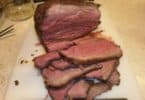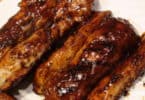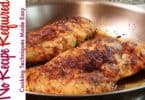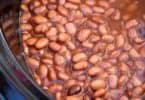 Cooked Goose
Cooked Goose
Goose is a savory, dark meat that many cooks find difficult to cook; however, by using proper and careful preparation, goose can be a rich and intensely flavorful treat.
PREPERATION
1. Before beginning, preheat the oven to 400° F.
2. First make sure the goose is completely defrosted, unless it is a fresh bird. Remove the neck, giblets, and fat deposits from the body cavity. The giblets can be refrigerated to be used for stock or gravy. The fatty deposits can be saved for rendering, which will yield a delicious cooking fat for other recipes.
2. Rinse the bird inside and out and thoroughly pat dry with paper towel.
3. Using a fork, prick the skin of the goose all over, including top and bottom. Be careful to pierce only the skin and not the meat. This will allow excess fat to drain during cooking, and aid in crisping the skin.
4. Next stuff the goose. An easy and flavorful option is to use 2-3 celery stalks (cut in 2 inch lengths) and a peeled and quartered onion. Another option is to stuff the bird with plain bread. A more familiar technique is to use stuffing. There are endless varieties of stuffing and flavorings, including apple, cabbage, prune, or traditional sage and onion. Prepare the stuffing beforehand using a favorite recipe.
5. Remove the wings or cover with aluminum foil to prevent burning. Fold the neck skin under and secure to the bird with a skewer. Tie the legs together with kitchen twine.
6. Rub the skin all over with salt and pepper to taste.
ROASTING Part 1
7. Place the bird, breast up, on a rack in a large roasting pan. Do not use a non-stick pan. Make sure the roasting pan is deep enough to collect all the fat that will accumulate during roasting.
8. Insert a meat thermometer deep into the thigh muscle. Make sure the thermometer is not touching bone.
9. Roast the bird at 400° F for about 45 minutes. This will give the bird a nice golden color, but make sure not to burn the goose. During roasting, spoon off any excess fat that accumulates at the bottom of the pan.
ROASTING Part 2
10. After browning the goose for 45 minutes, remove the pan from the oven. Reduce the oven temperature to 325° F.
11. Drain the fat from the pan and use paper towels to pat off any excess fat from the bird.
12. Cover the roasting pan and return to the 325° F oven. Cook the bird an average of 20 minutes per pound (for example, a 10 pound bird x 20 minutes per pound = 200 minutes, or about 3 hours and 20 minutes).
13. Every 20-30 minutes during roasting, skim the fat in the pan, and baste the goose with the pan juices. It is best to use a metal bulb baster because the hot, fatty juices may melt a plastic baster.
14. The goose is done when the meat thermometer reads 175°-185° F. Pierce the bird to ensure the juices are clear; the drumsticks should separate easily from the goose. If the bird is stuffed, make sure the stuffing has reached an internal temperature of at least 165° F.
15. When the bird is done, remove from the oven and transfer to a serving platter. Remove the kitchen twine from the legs and the foil on the wings. Cover the entire goose with foil and let it rest for at least 20 minutes before carving.


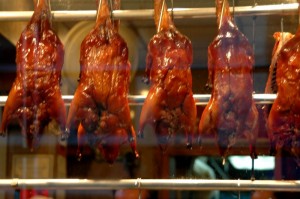 Cooked Goose
Cooked Goose
